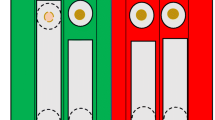Abstract
Thirsty rats made 10, 30, or 90 licks at an empty spout for 10, 30, or 90 licks at a water spout. In the first experiment, three groups of six experienced a perfect positive, negative, or zero correlation between the number of empty licks required and the consequent number of water licks. The behavioral price of the water lick was the same for all three groups in terms of total empty licks/total water licks. But in terms of the arithmetic mean of the individual prices, the positive correlation imposed the lowest price, the negative correlation the highest. As the mean price increased the rats made fewer water licks, in accordance with the demand law, and licked more efficiently, getting more water per lick. In the second experiment, six rats chose between perfect positive and perfect negative correlational episodes. They showed at best only a slight preference for the positive, 55% on average, but started positive episodes much sooner than negative episodes. In the third experiment five rats chose between an imperfect positive and an imperfect negative correlation that represented a relatively small difference in terms of mean price. They chose each correlation 50% of the time on average, and they started positive episodes no sooner than negative ones. The overall pattern of results suggests that rats code price in terms of the arithmetic mean of the individual prices they have experienced and not in terms of the total cost relative to the total amount consumed over a particular interval of time.
Similar content being viewed by others
References
ALLISON, J. (1977, May). Economics and operant conditioning. Paper presented at the meeting of the Midwestern Psychological Association, Chicago, IL.
ALLISON, J. (1979). Demand economics and experimental psychology. Behavioral Science, 24, 403–415.
ALLISON, J. (1981). Paired baseline performance as a behavioral ideal. Journal of the Experimental Analysis of Behavior, 35, 355–366.
ALLISON, J. (1983). Behavioral economics. New York: Praeger.
ALLISON, J., BUXTON, A., & MOORE, K. E. (1987). Rats’ responses to molar and local schedule constraints. Animal Learning and Behavior, 15, 360–367.
ALLISON, J., & CASTELLAN, N. J., Jr. (1970). Temporal characteristics of nutritive drinking in rats and humans. Journal of Comparative and Physiological Psychology, 70, 116–125.
ALLISON, J., MILLER, M., & WOZNY, M. (1979). Conservation in behavior. Journal of Experimental Psychology: General, 108, 4–34.
ANDERSON, N. H. (1981). Foundations of information integration theory. New York: Academic Press.
BUXTON, A., & ALLISON, J. (1990). Efficiency and persistence of licking in rats. Physiology and Behavior, 47, 239–247.
CROSSMAN, E. K. (1968). Pause relationships in multiple and chained fixed- ratio schedules. Journal of the Experimental Analysis of Behavior, 11, 117–126.
FELTON, M., & LYON, D. O. (1966). The post-reinforcement pause. Journal of the Experimental Analysis of Behavior, 9, 131–134.
FERSTER, C. B., & SKINNER, B. F. (1957). Schedules of reinforcement. Englewood Cliffs, NJ: Prentice-Flail.
HERRNSTEIN, R. J., & LOVELAND, D. H. (1975). Maximizing and matching on concurrent ratio schedules. Journal of the Experimental Analysis of Behavior, 24, 107–116.
HOLLANDER, M., & WOLFE, D. A. (1973). Nonparametric statistical methods. New York: Wiley.
HURSH, S. R. (1980). Economic concepts for the analysis of behavior. Journal of the Experimental Analysis of Behavior, 34, 219–238.
LEA, S. E. G. (1978). Psychology and economics of demand. Psychological Bulletin, 85, 441–466.
LEA, S. E. G., & ROPER, T. J. (1977). Demand for food in fixed-ratio schedules as a function of the quality of concurrently available reinforcement. Journal of the Experimental Analysis of Behavior. 27, 371–380.
MINTZ, D. E., MOURER, D. J., & GOFSEYEFF, M. (1967). Sequential effects in fixed-ratio postreinforcement pause duration. Psychonomic Science, 9, 387–388.
MONROE, K. B., & PETROSHIUS, S. M. (1981). Buyers’ perceptions of price: An update of the evidence. In H. H. Kassarjian & T. S. Robertson (Eds.), Perspectives in consumer behavior (3rd ed., pp. 43–55). Glenview, Il: Scott Foresman.
POWELL, R. W. (1968). The effect of small sequential changes in fixed-ratio size upon the post-reinforcement pause. Journal of the Experimental Analysis of Behavior, 11, 589–593.
SHAPIRO, N., & ALLISON, J. (1978). Conservation, choice, and the concurrent fixed-ratio schedule. Journal of the Experimental Analysis of Behavior, 29, 211–223.
THALER, R. (1985). Mental accounting and consumer choice. Marketing Science, 4, 199–214.
WINER, B. J. (1962). Statistical principles in experimental design. New York: McGraw-Hill.
Author information
Authors and Affiliations
Additional information
We thank Kevin Moore, Mike Perry, and Jim Logan for their help with the research. Jim Dougan, Justin English, and Don Gawley provided valuable comments on the manuscript.
Rights and permissions
About this article
Cite this article
Allison, J., Buxton, A. The Cognition of Price. Psychol Rec 42, 87–115 (1992). https://doi.org/10.1007/BF03399589
Published:
Issue Date:
DOI: https://doi.org/10.1007/BF03399589




